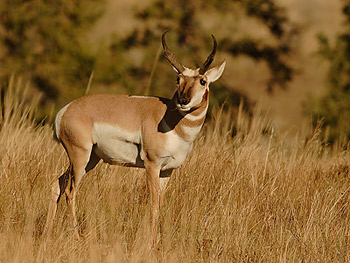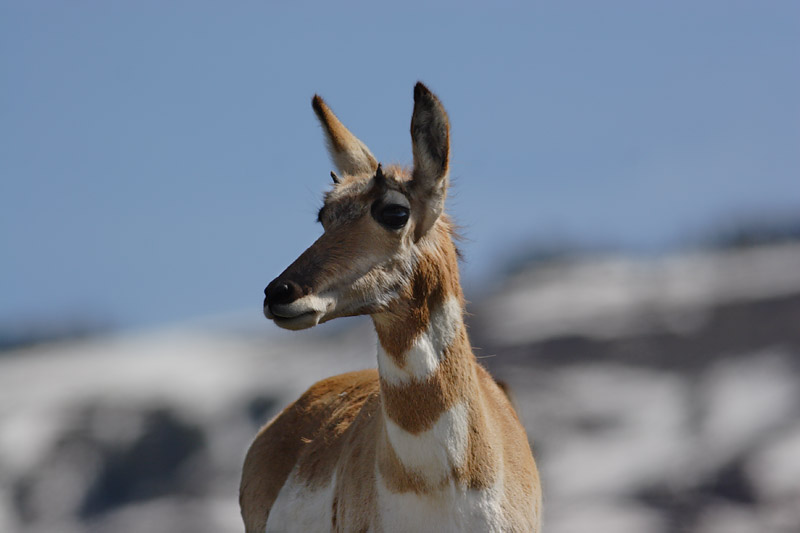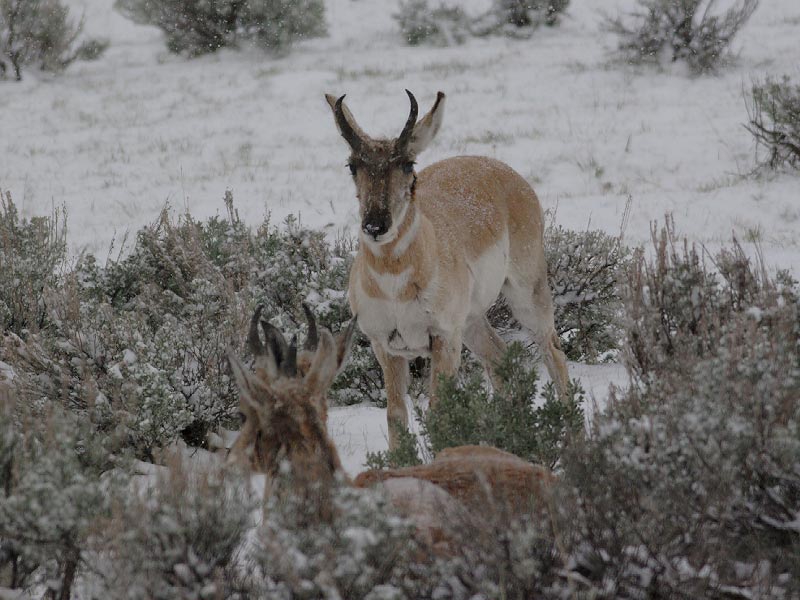The antelope stared at the wolves and pivoted as a group as the pack moved by. They bunched tightly together but did not run even though 17 members of the Druid Peak pack were

on the move barley 30 yards away.
The pronghorn even seemed to inch closer as if drawn to the drama that was unfolding in the Lamar Valley.
Suddenly a younger wolf stopped, alertly staring at the group. The energy of the whole
pack seemed to shift and they exploded in rapid succession towards their prey.
The antelope were at top speed in an instant racing as one for a small gap in the line of predators,
a seemingly small chance for freedom that was closing rapidly. But the dance with death was over
as quickly as it had begun with the antelope shooting through the running pack with ease
and leaving them a good half mile behind in mere seconds.
The fastest land mammal in North America is no easy meal and pronghorn antelope
is rarely caught by any predator.
Pronghorns are wonderous creatures, with their graceful and delicate appearance
and striking colors they seem like something from the Kalahari not Wyoming.
 Like most ungulates they move in small groups for safety, the more eyes watching for
trouble the better. They seem almost tame, if you stay along the road, passing only
yards away. But if you are out hiking, like all Yellowstone fauna they are more wary, so expect them to keep their distance.
Like most ungulates they move in small groups for safety, the more eyes watching for
trouble the better. They seem almost tame, if you stay along the road, passing only
yards away. But if you are out hiking, like all Yellowstone fauna they are more wary, so expect them to keep their distance.
Pronghorns are almost always found in open grassy plains and are fairly easy to spot. Traveling in groups of 3 to 10 they graze along slowly but every now and then they go tearing around the valley for no apparent reason other than the fun of seeing how fast they can go.
The chances of seeing Pronghorns in Yellowstone are very good if you try.
I have seen them often in the plains from
Idaho Falls to the west entrance of the park.
 They can also be found in the hills behind Mammoth Hot Springs, along Rescue Creek Trail, and through out Little America,
but the most reliable place I have seen them is in the Lamar Valley. Look all along the bottom of the valley
for small herds of the white and brown ungulates but don't be surprised if they are right up next to the road.
The babies are born in June and are very small and playful.
They can also be found in the hills behind Mammoth Hot Springs, along Rescue Creek Trail, and through out Little America,
but the most reliable place I have seen them is in the Lamar Valley. Look all along the bottom of the valley
for small herds of the white and brown ungulates but don't be surprised if they are right up next to the road.
The babies are born in June and are very small and playful.
I've seen 3 antelope-wolf confrontations and each time the antelope
didn't seem as concerned as I thought they would be even to the point of following the canids around
after the chase, appearing to dare the wolves to try again. They seem to be fully aware of the safety
their speed affords them and it's a pure joy to watch them race across the plains in the freedom that Yellowstone provides.
Incidentally, the damage to the buck's shoulder in the top picture, I was
told by a park wildlife biologist, was
caused by either multiple barb wire damage or a cougar had gotten a hold of it. He said that the
cougar research team had documented multiple attacks on antelope by
mountain lions on Blacktail Deer Plateau,
so apparently the sneak attack of a burst preditor like a cougar can be one of the few ways a prongorn can be preyed upon.
Tim Springer - 2004
|

